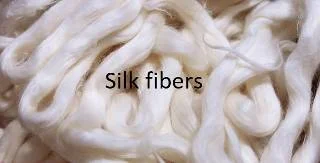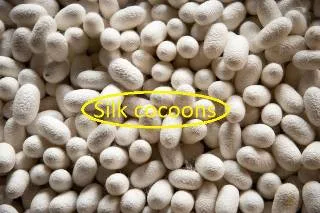Silk fiber
The
word silk comes from Old English: Sioloc, from ancient Greek: σηρικός,
Romanized: serikos, "silken", finally compare Mandarin from Asian
sources Mandarin s ī "silk". Silk fiber is a natural protein
fiber that we get from insects that can be woven into textiles. Silk protein
fibers are composed mainly of fibroin and some insect larvae produce cocoons.
The most well-known silk gun (sericulture) mulberry silkworm is obtained from
the larvae cocoon of Bombyx mori. The shiny appearance of silk is due to the
triangular prism structure of silk fiber which allows the silk fabric to
reflect the light coming from different angles, thus producing different
colors. The silk fiber is produced by several insects but moth caterpillar
silks are used to make textiles. There have been some studies on other types of
silk, which differ at the molecular level. Silk is generally produced by the
larvae of fully transformed insects, but some insects like web spinners and
racist crickets make lifelong silk.
History of Silk
Neolithic
1st silk production in China. During the last half of the first millennium BC,
the Silk Road was confined to China until it reached a certain stage. China has
maintained a virtual monopoly on silk production for thousands of years. Not
limited to clothing, silk was also used for many other applications, including
composition, and the color of the silk worn was an important guide to social
class during the Tang Dynasty.
Silk
cultivation spread to Japan around 300 AD and during Byzantine time silkworm
eggs were able to hatch and silkworm farming was started. The Arabs also
started producing silk at the same time. As a result of silk cultivation,
Chinese silk exports became less important even though they still dominated the
luxury silk market. The Crusades brought silk production to Western Europe,
especially to many states in Italy that saw the export of silk to the rest of
Europe at an economic pace. The Industrial Revolution changed much of Europe's
silk industry. Due to the invention of spin cotton, it became much cheaper to
make cotton and as a result, more expensive silk production became less
mainstream.
New
weaving technologies, however, have increased production efficiency. Among
these was the Jacquard loom, which was made for silk embroidery. Epidemic
production of several silkworm diseases declined, especially in France, where
the industry never recovered. In the twentieth century, Japan and China
regained their former role in silk production, and China is now again the
world's largest producer of silk. The emergence of new fabrics like nylon has
reduced the prevalence of silk around the world and silk is now again a rare
luxury good, less important than its turbulent days.
Properties of silk fiber
i. Silk filament is very
strong due to its linear, beta configuration polymers and very crystalline
polymer system. Its strength reduces when wet.
ii. Degummed silk's specific
gravity is 1.25.
iii. It is flexible enough and if used to make
garments then the fabric drapes well.
iv. It has an elongation at a break of 20-25% under
normal conditions.
v. It is a poor conductor of electricity and tends
to form a static charge when it is handled.
vi. It is considered to be more plastic than elastic
because it's very crystalline polymer does not permit the amount of
polymer movement which could occur in a more amorphous system
vii. It is less absorbent than wool but more
absorbent than cotton but it is a crystalline polymer.
viii. Silk fiber dissolves in
concentrated mineral acid but organic acids do not harm it.
ix. It is not as sensitive as wool to alkalis,
but it can be damaged if the concentration and the temperature are high enough.
x. Strong bleaches destroy silk fiber, but hydrogen
peroxide does not affect it.
xi. Raw silk is more
resistant to light than degummed silk.
xii. It is resistant to mildew effects.
xiii. It has a very good affinity to dyes such as
acid, basic and direct dyes.
Silk fiber composition
Fibroin
- 76%
Sericin
- 22%
Fat
& wax - 1.5%
Mineral
salt - 0.5%
Cultivation of Silk
Silk
moths lay their eggs
mainly on prepared paper. Eggs are hatched and dried fresh mulberry leaves are
fed. After about 35 days and 4 hatchings, the caterpillars become 10,000
times heavier than the cubs and are ready to start cutting a cocoon. A straw frame
is placed on top of the caterpillar tray and each caterpillar moves its
head in a pattern and begins to spin a cocoon. The two glands produce liquid
silk and force it through the opening of the head called spinnerets. Liquid
silk is coated with sericin, a water-soluble protective gum, and solidifies in
contact with air. Within 2-3 days, the caterpillar spins about 1-mile filament
and is completely enclosed in a cocoon. Silk farmers heat the cocoons to kill
them and turn some into insects to breed the next generation of dry ones. The
cut cocoons are boiled and the silk fibers soaked in water hold the silk fibers
together to form a cocoon. The fibers are then unwrapped to form unbroken
threads. Since the single thread is very delicate and fragile for commercial
use, three to ten strands are cut together anywhere to make a single thread of
silk.
Silk fiber manufacturing process
The
silk fiber manufacturing process
manual is as follows-
i. Sericulture
The
cultivation of silkworms to produce silk is called sericulture. The best raw
silk is obtained from insects of the species Bombyx mori. Silkworms breed once
a year but can be kept up to three times a year under scientific conditions.
About 3 mm larvae emerge from the eggs. Female silkworms lay 300 to 500 eggs. Silkmoth eggs form larvae or caterpillars known as silkworms. The larvae
feed on the leaves of the larvae. After growing several times, the silkworm
pulls out a silk fiber and forms a net to hold itself. It always itself
from side to side distributes saliva which will make silk. Silk hardens
when in contact with air. The silkworm spins about a mile of filament
and in about two or three days completely encloses itself in a cocoon. As a
result, about 2,500 silkworms are needed to produce about one thousand pounds
of raw silk. The intact cocoon is cooked, the silkworm kills the pupa.
Silk is obtained by brushing the useless cocoon to find the outer edge of the
filament. The filaments of silk are then wound into a relay. A cocoon contains
about 1000 yards of silk filament. Silk at this stage is known as
raw silk. A thread has 48 separate silk filaments.
ii. Shorting cocoons
The
cocoons are selected according to color, shape, and texture, as they all affect
the final quality of the silk. Cuckoos can range in color from white or yellow
to gray, depending on the source and type of food when eating at the insect
stage. Cocoons from China are white, Japanese cocoons are creamy-white and
yellow, Italian cocoons are yellow.
iii. Softening sericin
After
the cocoons are picked and the silk gum is called sericin, which cements the
filaments. Sericin is removed by placing the cocoon in hot water, which frees
the silk fibers and prepares them for reeling. This is known as the degumming
process. Immersion in hot water also kills silk math pupa.
iv. Reeling
Reeling
can be achieved manually or automatically. The end of the cocoon fiber is
brushed to identify. The method is as simple as it is laborious. It is threaded
through a porcelain eyelet, and the fiber is reeled on a wheel. Meanwhile,
diligent operators check for filament errors as they are being relayed. As soon
as each filament is almost finished reeling, a new fiber is bent into it,
creating a long, unbroken thread. Ceresin contributes to the attachment of
fibers to each other. The average cocoon reels about three hundred yards away
in a single thread.
v. Throwing
The production of yarn from silk, known as throwing, involves adding or twisting a twist and twisting these strands to the desired shape. The single filaments are joined together to form a thread, which is drawn by pulling through several guides and hitting the reels. Threads can be driven to make yarn. After drying, the raw silk is packed according to the quality.












0 Comments